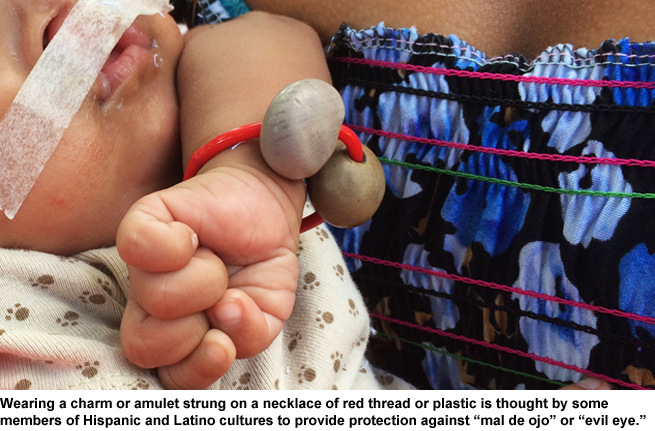 Recognizing and showing respect for cultural and spiritual beliefs help build trusting relationships, increase patient satisfaction, and promote positive outcomes.
Recognizing and showing respect for cultural and spiritual beliefs help build trusting relationships, increase patient satisfaction, and promote positive outcomes.
 It’s another hectic yet rewarding day in the pediatric clinic. A 2-week-old Hispanic infant arrives for a well child visit. You note a red-thread bracelet with a stone on her left wrist and are immediately concerned about it presenting a possible choking hazard. Her mother informs you that the amulet offers protection against “mal de ojo,” or “evil eye.” How should you respond? Have you encountered similar bracelets in your practice and been curious about them?
It’s another hectic yet rewarding day in the pediatric clinic. A 2-week-old Hispanic infant arrives for a well child visit. You note a red-thread bracelet with a stone on her left wrist and are immediately concerned about it presenting a possible choking hazard. Her mother informs you that the amulet offers protection against “mal de ojo,” or “evil eye.” How should you respond? Have you encountered similar bracelets in your practice and been curious about them?
The Hispanic or Latino population of the United States has increased in recent decades and is currently estimated at 56.6 million, or 17.6 percent of the population. You likely have encountered patients who identify as Hispanic or Latino. Hispanic (Purnell, 2013) refers to people with a Spanish-speaking background, and Latino refers to people of Mexican, Central American, Caribbean, or South American descent.
Culture can and does impact health beliefs and practices. Latino families may have strong beliefs in folk illnesses such as “empacho” (blocked intestine), “mollera caida” (sunken fontanel), and “susto” (fright), in addition to mal de ojo. We may encounter these beliefs during practice, but families who practice traditional or folk medicine may be reluctant to disclose or discuss the practice with healthcare providers.
Folk medicine is a combination of beliefs and traditional healing medicine practiced by certain cultural or ethnic groups. It may involve the use of plants, spirituality, or manipulative therapy. It is essential to be aware of and perhaps acknowledge these cultural beliefs in your practice. Doing so can build trusting relationships, promote adherence to a treatment plan, and increase patient satisfaction.
Mal de ojo is the most commonly reported folk illness among Mexican and Latino families in the United States. The malady is thought to occur voluntarily or involuntarily when an individual with “strong eyes” looks at a child, smiles, or offers compliments. This behavior is thought to cause illness by “heating up” blood, resulting in one or more of the following symptoms: inconsolable crying, diarrhea, fever, and gassiness. To counteract the harmful effects of nontactile admiration, the admirer should touch the child.
Wearing a charm or amulet on a necklace or bracelet is thought to provide protection against evil eye. The bracelets are often composed of red thread or plastic, because red is thought to divert the admirer’s attention away from the infant. The bracelets or necklaces may include a seed or an image of the Virgin Mary. The seeds are known as “azabache” or “ojo de venado” (deer eye). Families interviewed during my recent trip to Nicaragua called the bracelets “macho y hembra” (male and female) as two seeds are found on these bracelets.
To heal a child affected by mal de ojo, a “curandero” (native healer) may “sweep” the body with a hen’s egg while reciting a declaration, borrowed from Christian liturgy, known as the Apostle’s Creed. After sweeping, the egg is broken and placed overnight in a saucer of water under the child’s bed. If the egg is found to have white spots in the morning, the child is confirmed to have mal de ojo.
Intercultural tips
Hispanic families traditionally value “personalismo” (formal friendliness) and “respeto” (respect), and many Hispanic cultures view casual conversation as an important prelude to business or personalismo. Family members are often quite ready to help me in my use of the Spanish language. Likewise, those who ascribe to a belief in mal de ojo are eager to discuss the red bracelets. To open communication and forge a relationship, the healthcare provider should address the relevant family member with an appropriate salutation—Mr. or Señor, and Mrs. or Señora. Avoid use of impersonal pronouns such as “tu” (you) unless instructed otherwise.
Become knowledgeable about beliefs and practices within your patient population. Awareness of one’s own values and beliefs is an important first step in acquiring cultural competence. Patience, time, careful listening, and a holistic approach are essential components of providing culturally competent care and establishing trustful, satisfactory patient relationships. Healthcare providers should first listen to the family’s perception of the patient’s situation before presenting their own perception. Negotiation may be necessary to find a mutually acceptable intervention and promote a positive outcome.
Back to that 2-week-old infant
Although your first response to viewing the bracelet may be to instruct the family to remove the potential choking hazard, this may be viewed as discourteous or offensive. Instead, acknowledge the presence of the amulet, and ask the family if it is worn for protection. This approach shows personalismo and respeto! Point out the potential choking hazard of the amulet and suggest alternative approaches, such as attaching the bracelet to the inside of clothing, to the crib, or somewhere outside of the infant’s reach. Another alternative might be to remove the stones or medals from the bracelet and have the baby wear only the red string or plastic bracelet. You might also instruct the family to inspect the site daily for irritation or tightness.
Summing up
Recognizing cultural and spiritual beliefs and showing respect for those beliefs in your practice will assist in building trusting relationships, increasing patient satisfaction, and promoting positive outcomes. RNL
Diane Langton, DNP, RN, PPCNP-BC, is clinical associate professor, Sam Houston State University School of Nursing, College of Health Sciences, in Huntsville, Texas, USA. Langton also has a degree in anthropology.
References:
Purnell, L. (2013). Guide to culturally competent health care (4th ed.). Philadelphia, PA: F.A. Davis Co.